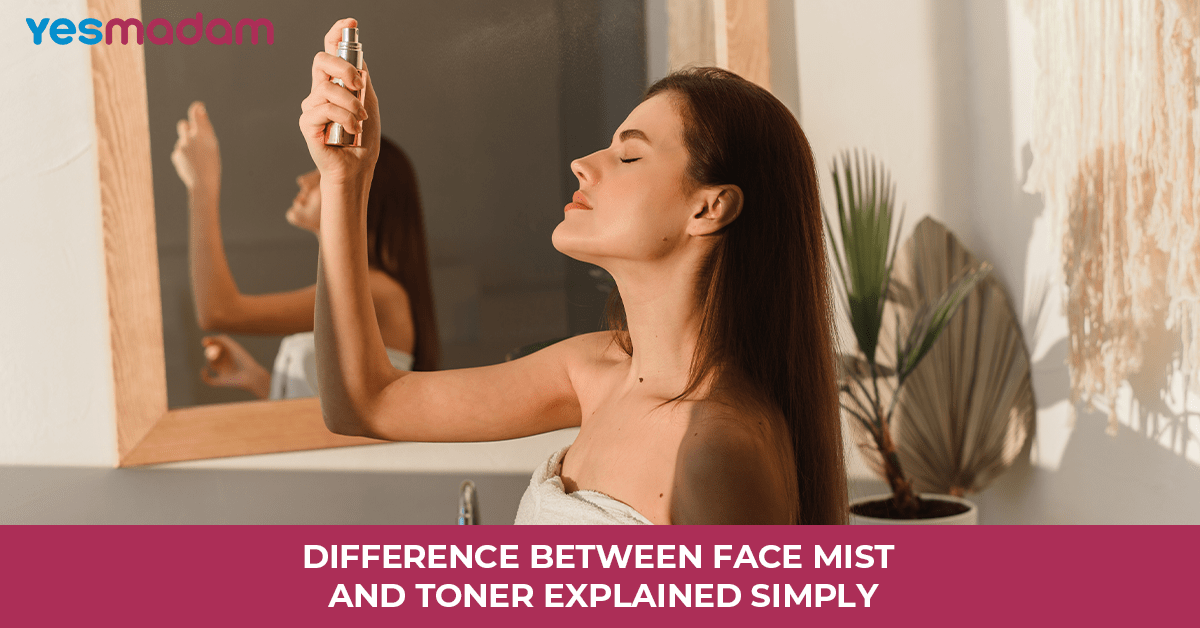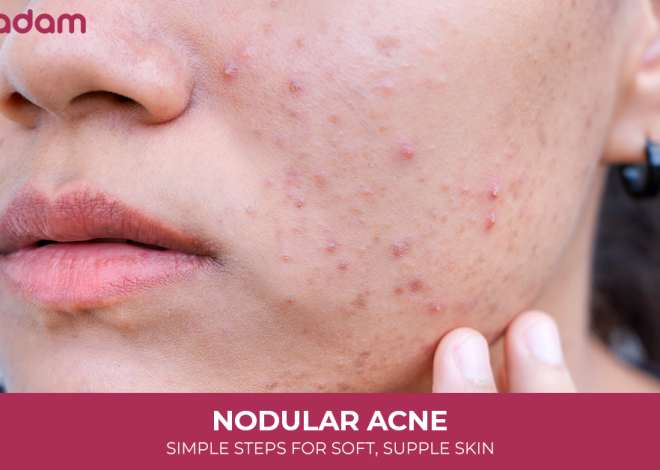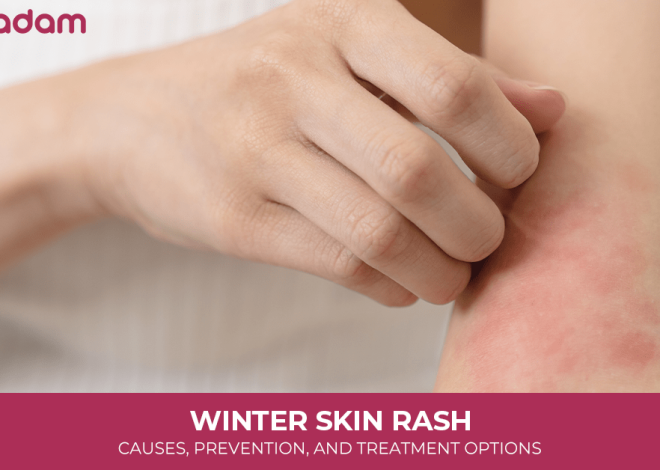
Difference Between Face Mist and Toner Explained Simply
Are you like most skincare enthusiasts under the impression that face mists and toners offer the same function and can be used interchangeably?
While you may be tempted to think they’re the same, face mist and toner play different roles and are chosen for use differently, as per skin type.
Well, this blog on the difference between face mist and toner has done extensive research on what face mists and toners are, how they work, tips for using both, pros and cons of each, and more.
Table of Contents
What is Face Mist, and Key Ingredients

A face mist is a lightweight, hydrating spray made to moisturize and refresh the skin all day long. Face mists are usually gentle and may be used many times in a day without stripping the skin of its natural oils.
Key ingredients to look for in face mist are:
- Hyaluronic acid: Provides hydration and leaves your skin feeling soft, smooth, and nourished.
- Aloe vera: Natural ingredient renowned for its hydrating properties.
- Glycerin: A natural moisturiser and effective humectant that helps draw moisture into the skin.
- Rose water: Lightweight, hydrating, and soothing, soothes skin irritation and minimizes the appearance of redness.
What is a Toner and Key Ingredients
Toner is a more targeted skincare product made to balance the skin’s PH level, eliminate leftover impurities after cleansing, and help prep the skin for moisturisers and serums.
Key ingredients to look for in a toner are:
- Salicylic acid: Unclogs pores, ideal for acne-prone skin.
- Lavender extract and witch hazel: Refresh and calm your skin.
- Omega fatty acids: Calms skin and assists skin in water retention.
- Ceramides: A group of lipids that reduce moisture loss.
Step-by-Step Guide: Tips for Using Face Mist and Toner
To maximize the benefits and to highlight the key toner and mist difference, let’s break down the steps on how to apply each product correctly:
How to use toner on face: A step-by-step guide
Here are the key steps on how to apply face toner for the best results:
- Cleanse: Apply a gentle cleanser to remove makeup, oil, and dirt.
- Pour: Dispense a few drops of toner on your fingertips or onto a cotton pad.
- Apply: Apply it evenly across your face, avoiding contact around the eye area.
- Allow to absorb: Wait for the toner to get fully absorbed into the skin.
- Follow up: Continue next steps with serums and moisturiser.
Simple tips and hacks for using a face mist: step-by-step guide
Here are the easy steps on how to apply face mist for the best results:
- Hold: Hold the face mist bottle about 6-8 inches away from your face.
- Spray: Spray the mist 2-3 times.
- Air -Dry: Air-dry your skin for a minute.
- Feel the difference: At last, feel your skin absorbing all the goodness.
Difference Between Toner and Mist

The main difference between mist and toner is purpose. Toners often contain astringent ingredients like alcohol, whereas mists are lighter and usually feature hydrating ingredients such as aloe vera or hyaluronic acid.
Toners
- Purpose: To deeply cleanse, remove remaining impurities after washing, balance the skin’s pH, and prepare the skin for better absorption of moisturizers and serums.
- Application: Applied with a cotton pad after cleansing.
- Ingredients: Can contain astringents like alcohol or witch hazel, and active ingredients like glycolic or salicylic acid to treat specific skin concerns.
- Usage: Typically used once or twice a day as part of your regular skincare routine, not on the go.
Face Mists
- Purpose: To provide instant hydration and refreshment, soothe the skin, deliver nutrients, and add a boost of freshness.
- Application: Sprayed directly onto the face.
- Ingredients: Water-based formulas with hydrating ingredients like aloe vera, essential oils, plant extracts, or hyaluronic acid.
- Usage: Can be used as needed throughout the day to refresh the skin or revive dull-looking makeup.
Face Mist vs Toner: Understanding The Pros and Cons Of Each
Let’s check the pros and cons of using face mist and toner, to help you make an informed choice on which is right for your skin or concerns:
Pros and cons of using a face mist
| Pros | Cons |
| It helps set makeup with a dewy finish. | Not all face mists are created equal. Water-based face mists will actually dry out your skin instead of hydrating it. |
| Provides an extra layer of moisture between skincare steps. | Avoid facial mists with high alcohol content, artificial fragrances, and harsh chemicals, as these may irritate your skin. |
| Offers an instant burst of hydration, especially in hot or dry environments. | Avoid spraying a face mist over makeup. |
| Cools down and refreshes skin during the day. | Similarly, using face mist may also mess with sunscreen’s effectiveness. |
Pros and cons of using a face toner
| Pros | Cons |
| Tightens pores and refines skin texture. | Allergic reactions in people sensitive to some ingredients. |
| Cleanses and removes residual makeup. | Dryness or irritation if it contains astringent ingredients or alcohol. |
| Controls oil production and prevents breakouts. | A burning or stinging sensation. |
| Restores the PH balance of your skin. | Over-drying may cause increased oil production in some people. |
When to Use Face Mist vs Toner
Choosing between face mist and toner varies as per your skin type and concerns:
- For dry or sensitive skin: Using both is beneficial. A face mist may provide moisture without irritation. Choose mists with soothing ingredients like cucumber or chamomile.
- For oily or acne-prone skin: A toner containing ingredients like witch hazel or salicylic acid may help regulate oil and keep breakouts at bay.
- For combination skin: Both.Toner after washing your face to regulate oil and a mist during the day to hydrate and refresh skin.
Conclusion
Understanding the difference between face mist and toner aids in making informed choices that improve your skincare routine. As skincare is personal in nature, check the ingredients of both face mist and toner to check that they suit your skin type. Patch test is important, whether you’re using a face mist or toner(especially for sensitive skin) to prevent allergic reactions.
FAQs
What is the difference between face toner and face mist?
The main difference is purpose and application: toners are used post-cleansing to balance skin pH and prepare it for subsequent products, while face mists are water-based sprays designed for instant hydration and refreshment.
Is mist and toner the same?
No, a face mist and a toner are not the same. A toner is used after cleansing to balance the skin’s pH. A face mist is a water-based spray used throughout the day for instant hydration.
Is face mist and toner same in terms of ingredients composition?
No, face mists and toners are not the same in terms of ingredient composition, although there can be overlap.
Should I use toner or face mist first?
You should use toner before a face mist in your skincare routine, applying the toner first to cleanse and prep the skin before using the face mist to add a boost of hydration and refreshment.
What can be used instead of toner?
Instead of toner, you can use products like micellar water and serums, or even simple DIY options like witch hazel, rose water, or rice water to achieve similar skincare benefits like hydration, cleansing, and soothing.
Is rose water a face toner?
Yes, rose water is a natural and gentle face toner that helps to hydrate, refresh, and balance the skin.
Can I use face mist instead of toner?
No, Face mists cannot replace toners because they lack the active ingredients that cleanse, balance, or target specific concerns.
Is it okay to use face mist every day?
Yes, it’s generally okay and often beneficial to use face mist every day, and you can reapply it multiple times throughout the day as needed to refresh and hydrate your skin.
Is face mist good for dry skin?
Yes, face mists are good for dry skin, as they provide instant hydration, replenish moisture, and soothe dehydrated skin.
Is rice water a toner?
Yes, rice water can be used as a natural toner to hydrate, brighten, and soothe skin, offering benefits like improved texture, tightened pores, and a radiant glow.



